This post, with a spotlight on PPC for law firms, is part of a series focusing on specific PPC strategies per industry. While the basic components of every PPC campaign are the same, no two are identical. Consult your industry’s guide for tailored tips!
For law firms, PPC campaigns are the digital marketing holy grail of client acquisition. Get it right, and you can attract new leads with a healthy cost-per-acquisition (CPA).
Indeed, KPIs always vary depending on the nature of your business. In fact, we analyzed 50,000 campaigns in 12 different industries and found striking comparisons from industry-to-industry. But with the rising cost of law-related keywords — not to mention fierce competition — generating leads through AdWords is hard no matter what you offer.
Marketing is already a tricky practice in any industry, but for law firms there are even more hurdles to overcome. For example, in the UK, there are strict rules around unsolicited approaches in person or by telephone.
This is why PPC is such an important channel for law firms, and also why it’s so competitive. So, how do you execute a PPC campaign that attracts your ideal leads while maintaining a healthy ROI?
In this guide, you’ll learn seven crucial techniques your AdWords campaigns must include to succeed in the competitive legal landscape. Once you’ve finished this guide, you’ll know exactly how to target and attract the right clients for your law firm.
1. Target the Right Regions
Targeting the right traffic is the most important step to a profitable PPC campaign. While keywords are key, law firms should start by targeting the right regions. If you’re a PPC veteran, you’ll know how basic this principle is, but many firms still fail to target the right geo locations. As a result, they appear in searches from irrelevant cities and states.
Let’s face it – even if you’re the best in the business, the perfect client won’t travel to you. To set your target regions, head to the “Settings” area from the left-hand menu in AdWords. Then, select your campaign, followed by “Locations:”
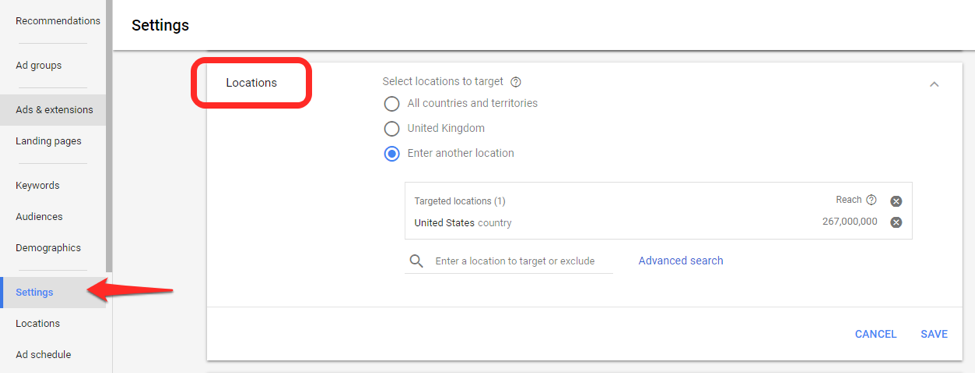
Next, click on “Advanced search.” In the pop-up box, select the “Radius” option:
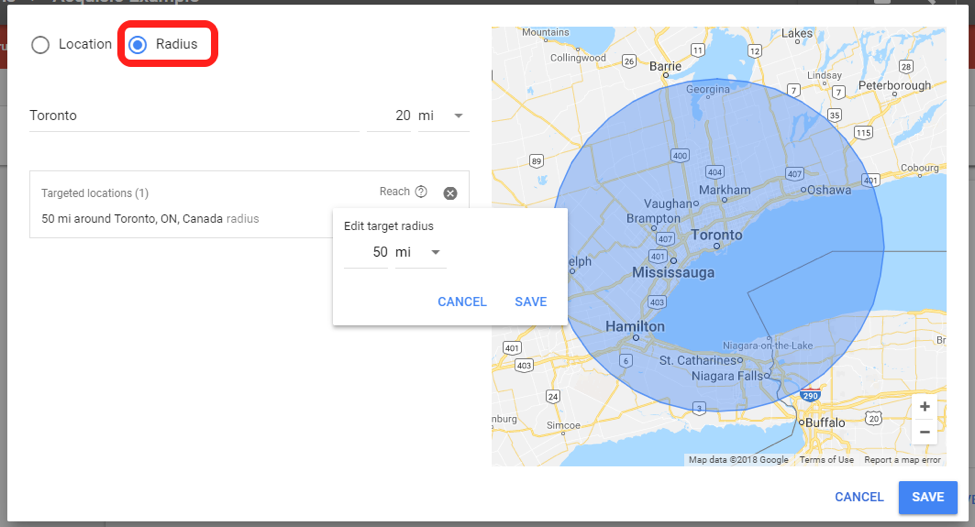
Here, you can enter a geographical location, followed by the target radius around that location. Add multiple target locations to one campaign or create a single target radius for each. I recommend you do the latter, as it gives you more flexibility when matching your ad creative to your target audience.
As well as location targeting, you may also want to experiment with the time of day you advertise. Read our guide “The Best Time to Advertise by Industry” to learn more, but generally speaking legal professionals should prioritize ads on Mondays and avoid weekends.
2. Focus on Search Intent
Not all keywords are created equal. Depending on what a user searches for, they may be looking for information or an immediate solution. This is called search intent.
The ads you serve for each “intent” must be adjusted – from the ad copy to the landing page you guide them to. Here’s a breakdown of the three categories of intent:
- Navigational: The searcher is looking for a brand or specific website. These are often called “branded searches.”
- Informational: This is where the user is looking for the answer to a specific question. They may also be looking for in-depth guides on how to overcome a challenge.
- Transactional: It’s highly likely the searcher is looking to buy something. As a result, these keywords have high “commercial intent.”
It’s likely most of your best prospects are searching for transactional keywords, like “family lawyer toronto.” These have a lot of competition, but this is a direct correlation to how profitable they are.
But what about informational keywords? Searchers within your target geo may be looking for information to a particular problem – a problem you can solve with content. For example, let’s say someone searches for the keyword “how to hire a family lawyer.” The searcher lives in your target area (e.g., “Toronto”) and would make a great prospect when they’re ready to talk business.
You could serve them an ad that directs them to the bottom of the funnel, e.g. “schedule a consultation.” Or, you could create content that solves this problem. In this example, you could create a blog post or a whitepaper called “How to Choose The Right Family Lawyer.” Using conversion techniques, like a form or content upgrade, you can then capture the prospect’s details.
From here, use back-end email marketing systems to nurture the relationship. When they are ready to invest in a service, it’s highly likely your brand will come to mind first. You were, after all, the firm that gave value up front.
Clients have more at stake than any other industry – whether that be money, reputation, or even their freedom. Providing educational content to clients is the best way to establish healthy relationships. The lack of client education out there provides you with a great opportunity.
Look at campaigns which target broad keywords. Are there any informational keywords which can be answered with content? If so, create this content and separate informational keywords into separate ad groups. You’ll see your Quality Score (QS), and lead generation efforts soar as a result.
3. Create Compelling Ad Copy
You’ve tightened your ad targeting, and you’re serving the right calls-to-action to the right searchers. Now you need to take that focused attention and drive them to your landing pages. Which brings us to the next step in the funnel: your ad creative.
To drive traffic, you need to compel prospects to click on your ad. This means standing out in a sea of competitors – especially in an industry as competitive as law. Here, I’ll outline five copywriting principles to apply to your PPC campaigns immediately.
Copywriting Tip #1: Get The Basics Right First
Writing copy for AdWords is a delicate art. Unlike landing pages, you’ve got a very limited amount of space to work with. However, you’ve got to keep basic copywriting principles in mind. Remember to check these boxes when writing your ad copy:
- Relevancy: A good QS comes from relevancy. Your ad copy must match the target keyword and the messaging of your landing page.
- Talk about them: If you’re using “we” more than “you,” go back to the drawing board. You must make your ad copy about the prospect and their pains.
- Focus on benefits: Again, forget about what makes your service great. Why do clients decide to do business with you? Focus on these benefits.

Copywriting Tip #2: Use Numbers
Have you generated impressive results for your clients? How many cases have you won in the last month or so?
Using numbers in your copy not only grabs attention, but it can also boost social proof. In fact, according to research by Conductor, headlines that contain numbers are more effective than any other headline format:
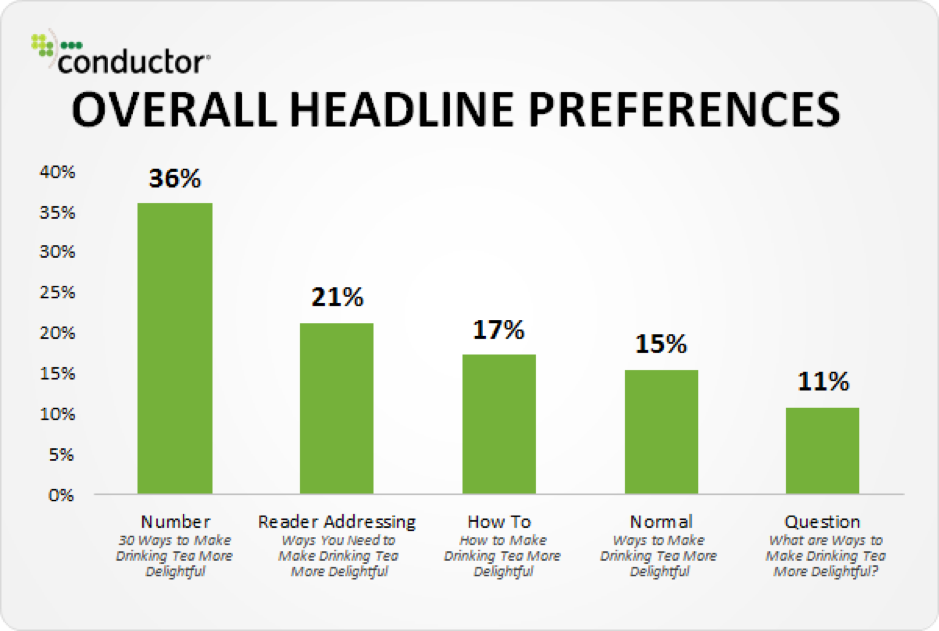
Here are some ways you can use numbers in your ad copy:
- Your average win-rate
- Number of clients
- Years in business
- Number of won cases
What you can and can’t include in your ad copy will vary from region to region. For example, in many Canadian provinces it’s forbidden to publish your win rate for advertising purposes, while in the US this is more relaxed. Make sure your ads abide by local regulation before going live.
Find ways to link social proof to the power of numbers. Use them in your headlines and see your CTR soar.

Copywriting Tip #3: Ask Questions
As I mentioned earlier, searchers are often on the hunt for answers to their questions, and solutions to their challenges.
Show that you get them by rephrasing these questions in your headline. In our family law example from earlier, these headlines would work well:
- “Looking For a Family Law Expert?”
- “Need Help Choosing a Family Lawyer?”
- “Choosing a Family Lawyer? Our Guide Will Help.”
These headlines fit within the “informational” searcher intent. Grab your prospect’s attention by using the same questions they’re already asking in their head.

Copywriting Tip #4: Use Emotional Triggers
You don’t have much room to play with when writing AdWords copy. But that doesn’t mean you can’t use the limited space to spike emotions using triggers and grab attention. Get to the heart of your prospect’s pain by spiking a feeling relevant to the problem they’re looking to solve.
Emotional triggers include:
- Trust: Your prospects need to know they can rely on you and that you’re a credible lawyer. How can you reinforce trust in your PPC ads (and your landing pages)?
- Value: Buyers are more price-savvy than ever. They’re aware of buyer’s remorse and will avoid it at all costs. Can you add a guarantee or make comparative offers from your competitors?
- Instant Gratification: The law is a long game. But people want instant gratification, and in the world of law, this can simply come in the form of easing their immediate woes. Use your copy to make prospects feel like they’re in safe hands.
- Hope: This is the emotion that drives us forward in hard times. Paint a picture of a brighter future, even when times are bleak.
- Fear: Is the emotion that drives the decision making in the process. If fear is a motivating factor, then all you need to do is show how your service is the right action for prospects to take.


Copywriting Tip #5: Always Be Testing
Of course, you won’t be able to fit all these elements into the same ad.
Which is why it’s important to test different ad variations against each other. To do this, head to the “Ads & extensions” section in your campaign. Click the “pencil” icon next to your highest performing ad copy and select “Copy and edit:”
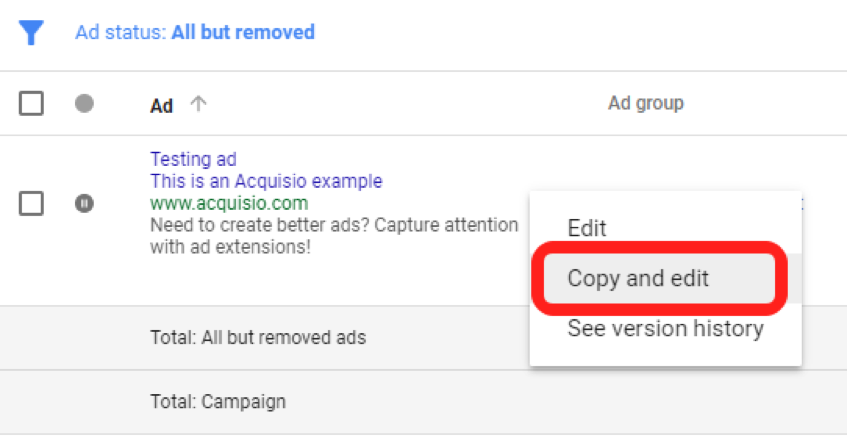
From here, it’s simply a matter of changing certain elements of your ad. Using the Ad Variations feature, you can quickly test different ads against each other. To set them up, head to the bottom of the left-hand menu and select “Drafts & experiments:”
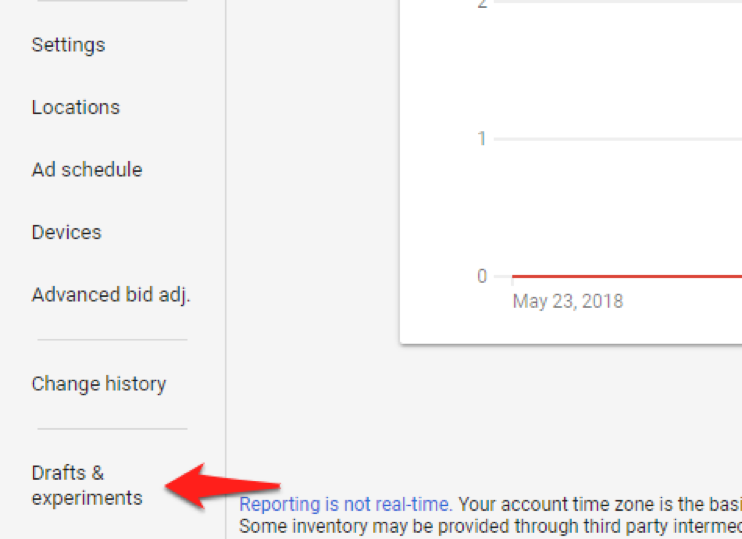
Under the “Ad Variations” tab, click “New Ad Variation.” From here, follow the wizard and apply the new variation to your selected campaign. With this powerful feature, you can replace specific text, swap headlines, and update entire sections of your copy with ease.
Test only one element at a time. Whether that’s the headline or call-to-action, it’s important to pick one. Otherwise, you’ll never know what improved performance in the first place.
4. The Anatomy of High-Converting Landing Pages
You now know how to create compelling ad copy that prospects can’t help but click.
Once clicked, your prospects will be taken to your landing page. And the job of the landing page is to convince prospects to take action. If your landing page isn’t designed for conversions, you’re going to waste money. There’s no point driving traffic to a landing page that doesn’t convert.
Here’s the thing: keywords are expensive. According to figures from SEMrush, the most expensive legal-related keyword is £81.40 (approx. $107) a click:
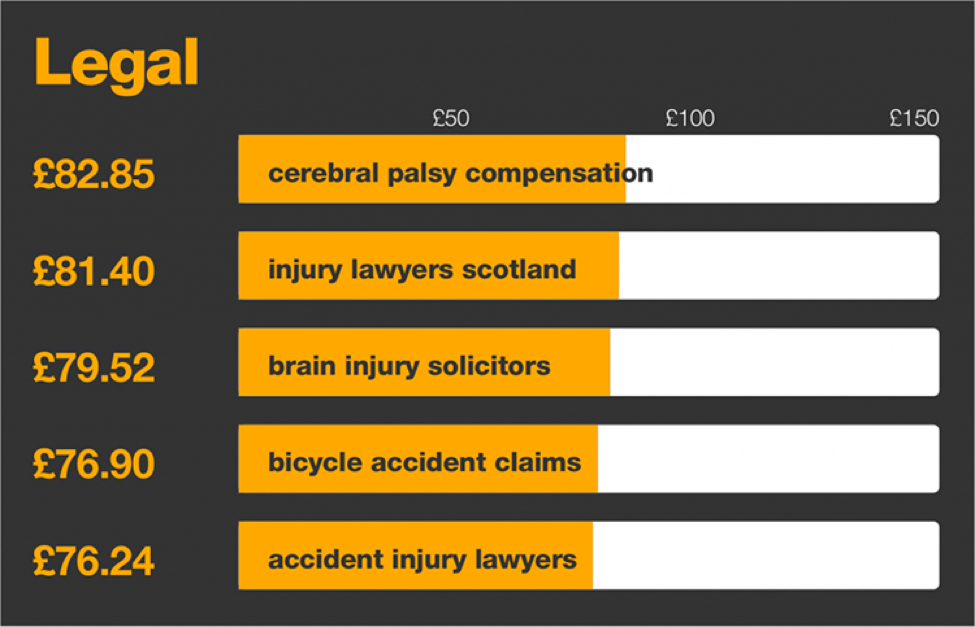
Which is why it’s super important your landing pages are engineered to turn as many of those clicks into leads. Here are five inquiry-generating elements that all landing pages must include in order to generate leads for your law firm.
Landing Page Element #1: Remove Navigation
Your landing page must guide prospects toward a specific action. This means removing all elements that distract from this objective. The navigation pane is the first distraction your prospect will see. Allowing them to browse the website will hurt conversions. Here’s an example from our friends at Unbounce:
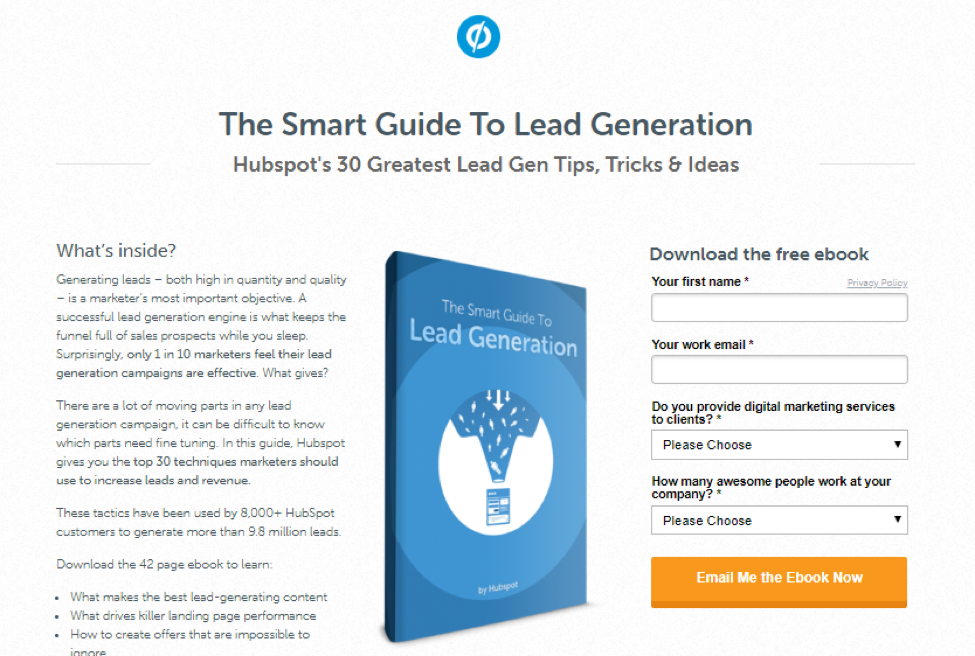
As you can see, downloading their eBook is the only thing a user can do. The header is clutter-free, while the eye is drawn to other elements on the page.
Landing Page Element #2: Use a Hero Shot
In the example from Unbounce above, they’ve included a large image of the eBook cover. This is known as “the hero shot.” Visual content is key, and when it comes to offering eBooks, white papers, and other content, the hero shot is easy to create. However, you may need to get creative. Service-based offerings don’t lend themselves to visual content, but luckily there’s an alternative.
Landing Page Element #3: Build Trust Using Video
When you can’t visualize with images, then your next best bet is to create video content. Video is one of the best ways to build immediate trust. For law firms, this gives you a chance to put your people and personality forward.
Creating video content is simple: stand in front of the camera and explain what you do. What makes your firm different? What’s the process for working with you? Adam Goodman, a Toronto-based criminal lawyer, is a great example of how simple it can be:
There’s nothing fancy here — just Adam talking about his process and what he can do for his clients. Shoot a video like this and embed it in place of the hero shot on your landing page.
Landing Page Element #4: Single Call-to-Action
Remember, you want your prospects to take one action, and one action only. Traditionally, this action is filling out a form. Your prospect will enter their details to download a whitepaper/request a call-back or consultation. Here’s another example from Unbounce:
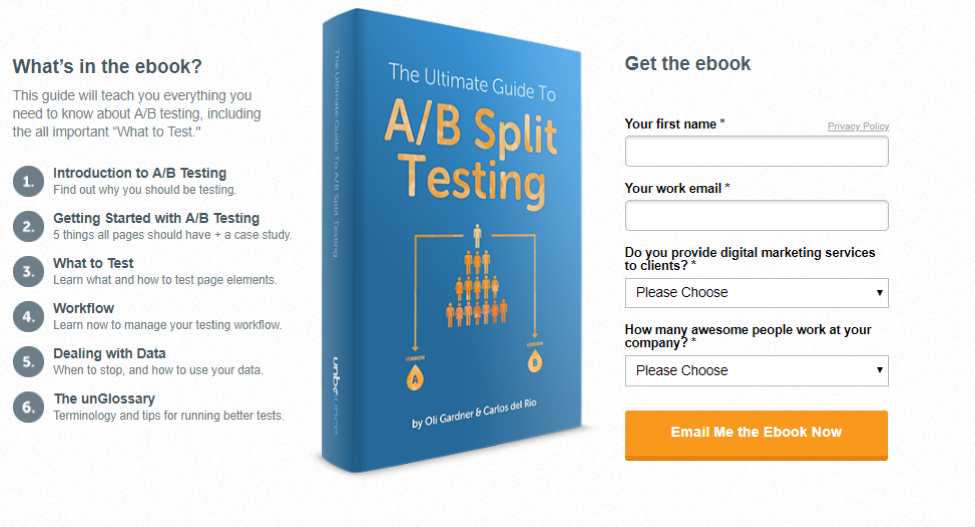
The layout is simple. It asks only for the most important details. But most importantly the call-to-action pops-out from the rest of the page. They use an orange button to grab attention. Furthermore, they reinforce the value proposition in the copy (Email Me the Ebook Now).
Form-friction is a term describing when prospects abandon a form due to its length. So, find the right form length for your practice. Ask for only the most critical information to begin a relationship with your new leads.
Landing Page Element #5: Social Proof
Building trust is one of the biggest hurdles to generating new law firm leads, as we mentioned in the ad copy section above. Get over this by including testimonials from happy clients. When acquiring them, ask your clients to be as specific as possible. Include the results, and why they loved working with you.
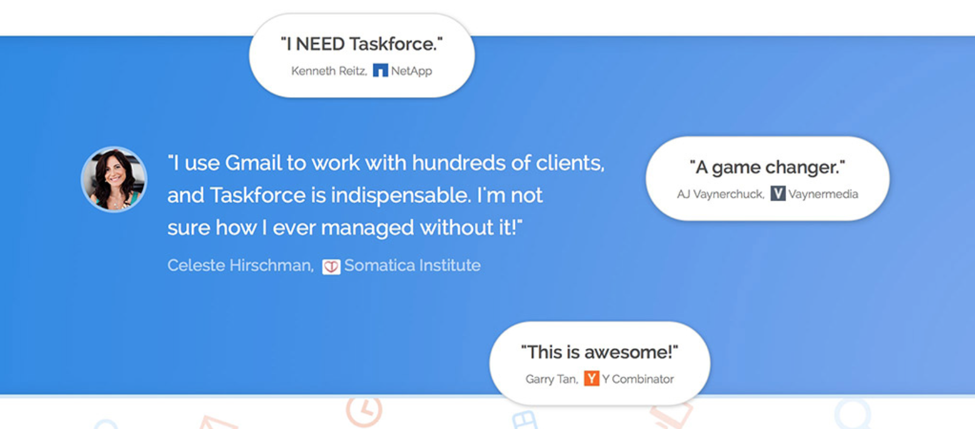
When applying them to your landing page, include a headshot and a full name. This proves that the testimonial is real and removes skepticism.
5. Streamline Inquiries with Call Extensions
When targeting the right keywords, those with commercial intent are your money makers. And sometimes, your prospects are desperate and want to speak with someone right away. Give them this option by including call extensions in your ads.
Call extensions are simply calls-to-action that appear under your ad when searched for on a mobile device. When a user clicks on the extension, their device automatically dials the number you provide them with.
To set up an extension, head over to “Ads & extensions” in AdWords and click the “Extensions” tab. Then, click on the blue “plus” button, followed by “Call extension”:
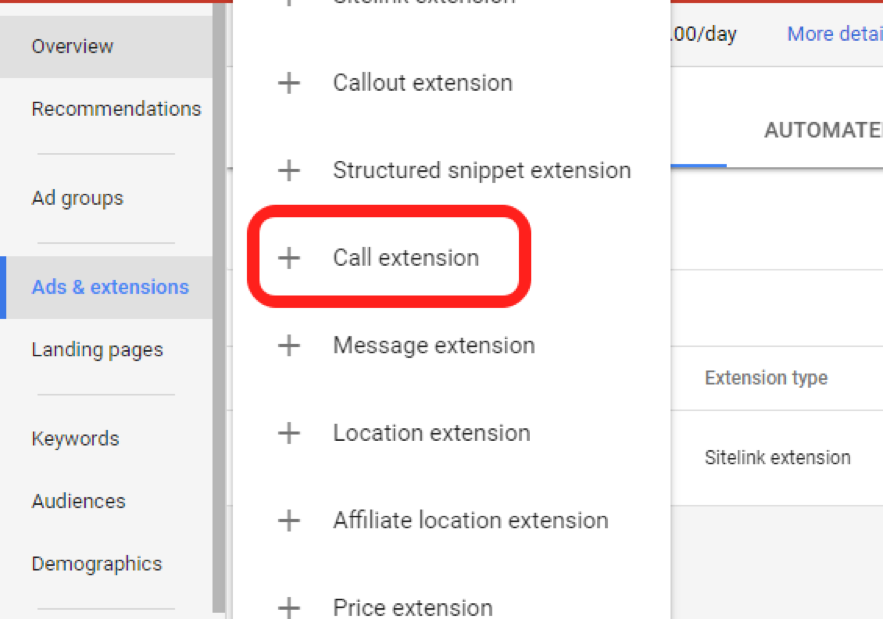
You’ll then be taken to the following page:
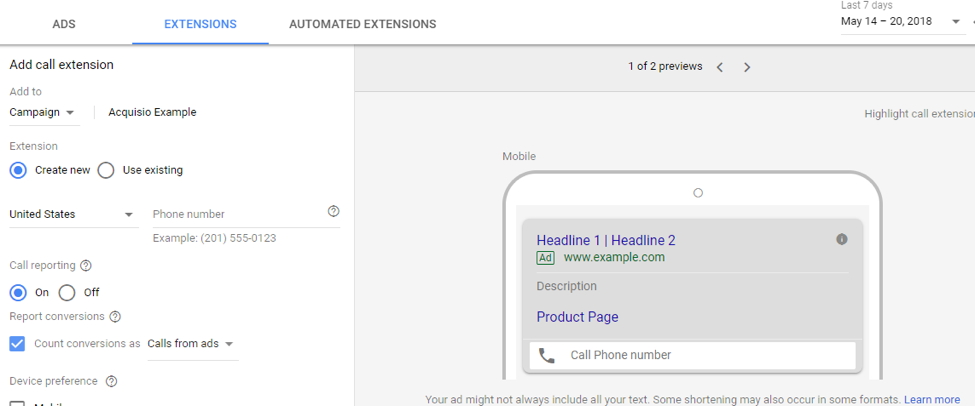
Let’s break down ad extension set up and what they should include:
- Add to: Select which campaign or ad group you wish to apply the extension to.
- Extension: Keep “Create new” selected.
- Country & number: Select your country of residence from the drop-down, followed by the phone number you wish to connect prospects to.
- Call reporting: Allows you to measure quantity and duration of calls. Learn more about call reporting from Google here.
- Device preference: You may wish to check “Mobile” if you only want the extension to appear on mobile ads. But this is a matter of preference.
Feel free to play with the other options, but we recommend leaving them as is. Once you’ve applied the extension to an ad group, your ad will look like this:
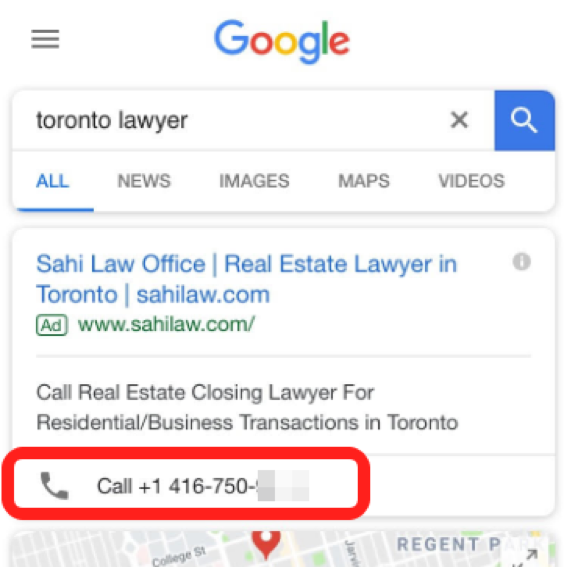
This provides a faster, more efficient method for your prospect and clients to reach you!
6. Analytics & Call Tracking
You should now have a robust AdWords campaign set up for your law firm. But the work doesn’t end there. You must continuously measure and optimize your PPC efforts to ensure you’re generating the best ROI possible.
It’s likely that many of your inquiries will come in the form of phone calls. Which is why I recommend you set up two forms of tracking:
- Google Analytics
- Call Tracking
Let’s start by linking AdWords with Google Analytics (GA). To do this, head to your GA account and navigate to Acquisition > AdWords > Campaigns. You’ll be presented with the following wizard:
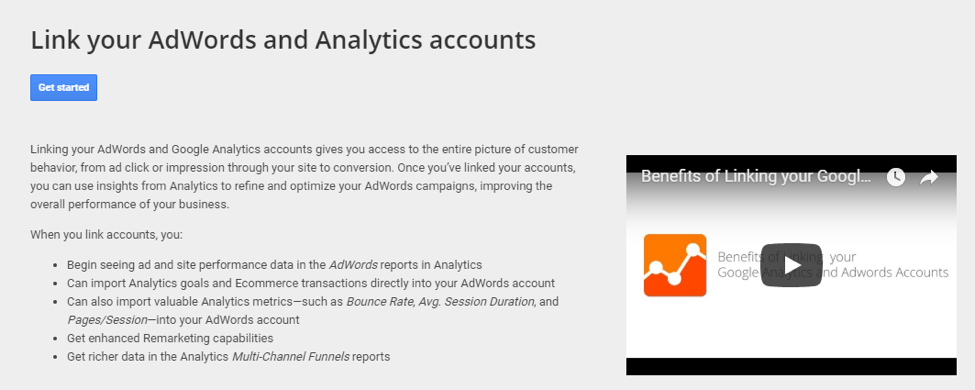
Click on “Get started” and follow the steps. Once completed, head back to Acquisition > AdWords > Campaigns. Over time, your AdWords data will appear here:
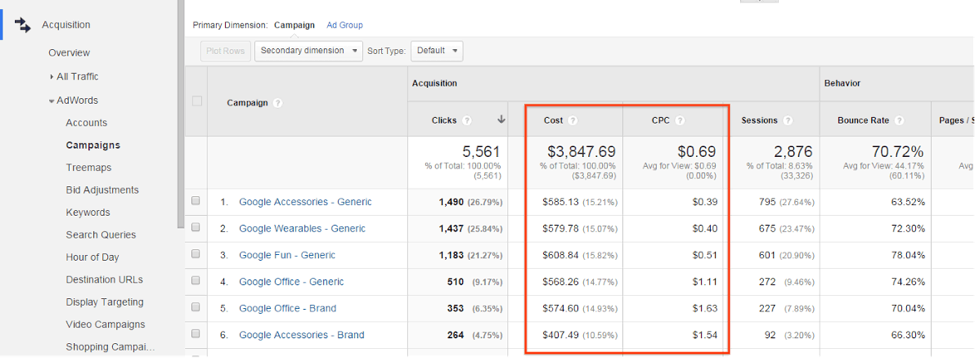
Then there’s call tracking. This technology allows you to measure where your calls come from, as well as the duration and overall quality. There are several solutions, depending on where in the world you are. Here are a few tools we recommend looking into:
Each system is different, but here’s a summary of how they work:
- A “dynamic” phone number is added to your website. This phone number changes for each visitor, provided from a “pool” of available numbers.
- When a user dials the number, it goes through the call tracking system.
- The platform then records where the call came from (PPC, organic search, etc.), the duration, and can record the call. Call recording allows business development managers to measure the performance of their teams.
With these two technologies in place, you can measure and optimize your AdWords efforts on an ongoing basis. Do this by testing new ad copy, creating ad groups for each of your highest performing keywords, and optimizing your landing pages for higher conversion rates.
7. Advanced Law Firm PPC Techniques
We’ve covered the basics of creating and executing a successful law firm PPC strategy. To end this guide, I’ll share two advanced techniques with you. These simple approaches will lead you towards better, more optimized AdWords campaigns and a greater ROI.
Advanced Technique #1: Exclude Competitor Clicks
It’s likely your competitors are keeping tabs on you (as you should them!) and regularly searching for your company name in Google. Which means they’re probably clicking on your search ads. This leads to wasted budget, as your competitors are not your ideal clients. Luckily, there’s a way you can put a stop this.
First, find their IP address by signing up for their email list. Using Gmail, open one of their newsletters, select the drop-down followed by “Show original”: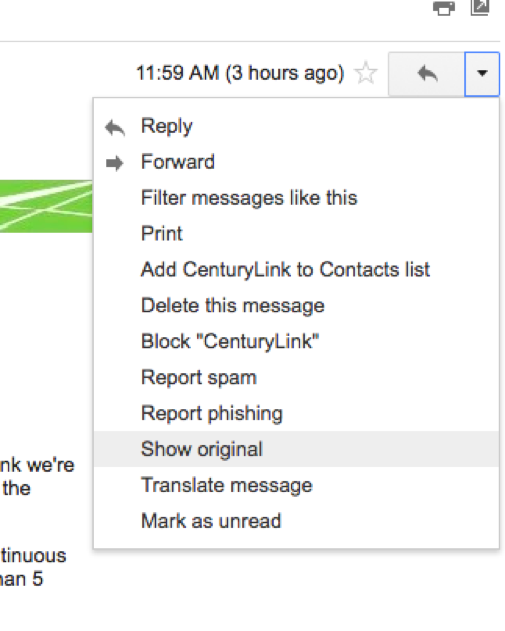
Hit ctrl+f and search for “Received: from” in the source. This will show the IP address the email was sent from (data censored for privacy):

This is the IP you’ll exclude from your campaigns. To do this, head to the Settings of your AdWords campaign, click “Additional settings,” followed by “IP exclusions.” Enter your competitor’s IP addresses in the following text box:
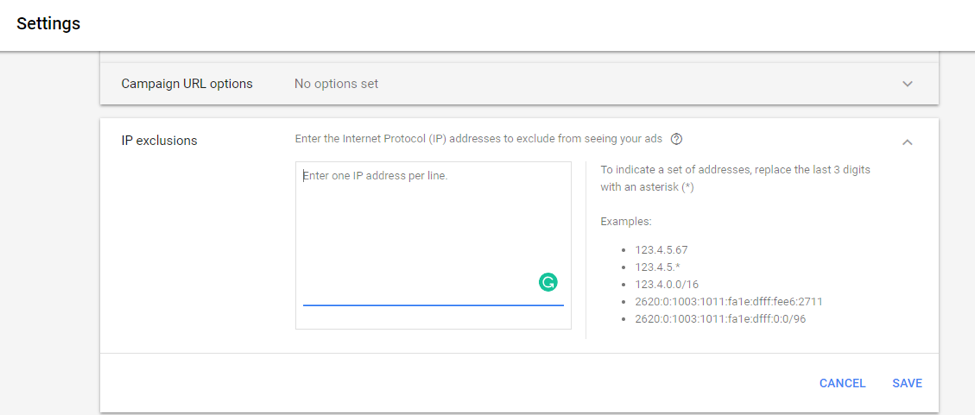
Now, whenever a competitor clicks your ads, you won’t pay for it.
Advanced Technique #2: Optimize Headlines to Increase Quality Score
Quality Score is arguably one of the most important PPC factors to optimize. Indeed, a higher QS means a lower CPC and a higher CTR. The quickest “win” for optimizing QS usually starts at the headline. Here are a few ways you can optimize your PPC headlines for a higher Quality Score:
- Include the keyword: To do this, create a separate Ad Group for each of your most important keywords as we mentioned above. Use that target keyword as early on in your headline as possible.
- Use punctuation: Punctuation can help you stand out, but be weary of AdWords best practices. This will make sure your copy doesn’t look a mess when the first line begins after your headline.
- Keep it up-to-date: What happens recently gets more attention. For example, you could include the number of clients you’ve served over the last year, or better, the last month.
- Include location: As well as keywords, add the city/region you’re targeting. This works best if you have created different ad groups for each of your target locations.
Of course, a good QS is the result of having all your ducks in order: target keywords, ad copy, landing page, etc. But the headline is a quick and easy place to start, and often yields the best rewards.
Putting It Together
These seven techniques will help you create more profitable AdWords campaigns and generate more clients for your law firm. To wrap-up this article, let’s look at the six stage funnel that ties it all together.
- Stage 1: Laser-Focused Targeting
Make sure you’re attracting the right traffic. The first step is to get your geo-targeting set up correctly. Make sure you’re serving ads to the cities and regions that you serve. - Stage 2: Pick the Right Keywords
In the beginning, you’ll likely target several keywords that don’t yield a return. But you must still ensure your targeting is as accurate as possible. This goes back to geo-targeting using phrases like “law firm toronto” coupled with specialized keywords like “family law toronto.” - Stage 3: Create Individual Ad Groups
To generate as much traffic while spending as little as possible, you must optimize your Quality Score (QS). The first step to this is ensuring your keyword and ad copy are as relevant as possible. The best way to do this is to create ad groups for each of your highest performing keywords. - Stage 4: Compelling & Attention-Grabbing Copy
You need to stand out from your competitors when a prospect searches for a target keyword. Do this with client-driven copy that focuses on their needs. - Stage 5: Use Ad Extensions
Ad Extensions are add-ons you can use in your ads to provide more information or give more actions for prospects to take. Use the Call Extension to allow prospects to reach you directly. - Stage 6: Conversion-Driven Landing Pages
Once your prospect clicks, it’s up to your landing page to turn them into inquiries. Conversion-driven copy and a compelling call-to-action are among many elements your landing pages need to turn prospects into leads.
As you can see, everything taught in this guide fits into this six-stage funnel. You must create a journey that guides your prospects to becoming a client. Do this by focusing on their challenges, building trust, and educating them.
Your Turn…
How are you currently using AdWords to grow your practice? Are there any successful techniques or approaches we’ve missed? Share your experiences in the comments below!
Image Credits
Feature Image: Unsplash / Sebastian Pichler
All screenshots by author, taken June 2018.
Image 1, 2, 9-10, 15-16, 22: Screenshot via AdWords
Image 3, 5-6, 7-8, 17: Screenshot of Google SERPs
Image 4: Conductor
Image 11: SEMrush
Image 12-13: Unbounce
Image 14: LandingFolio
Image 18-19: Google Analytics
Image 20-21: Gmail



